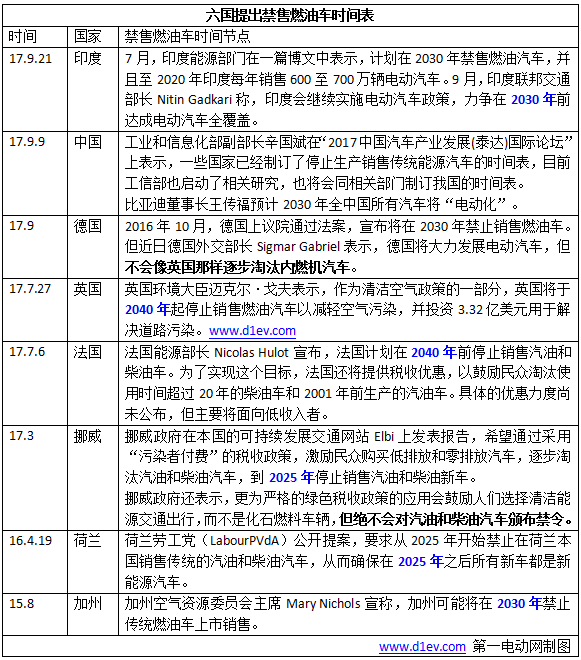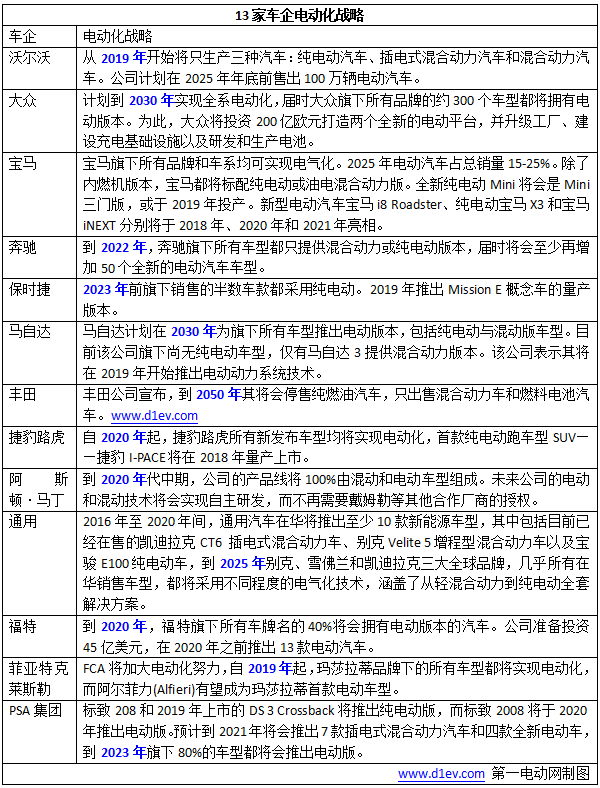As the electrification boom sweeps across the globe, many European countries have successively issued timetables for banned fuel vehicles. In this context, a number of car giants have announced the “electricity†strategy.
Six countries propose a ban on the sale of fuel vehicles
As early as two years ago in 2015, Mary Nichols, chairman of the California Air Resources Committee, declared that California may ban the sale of conventional fuel vehicles in 2030. In 2016, the lower house of the Dutch parliament expressed support for a bill proposed by the Labor Party. The act requires the Netherlands to prohibit the sale of new gasoline and diesel vehicles from 2025 onwards. The market will only allow electric vehicles to be sold.
In October 2016, the German House of Lords passed a bill announcing that it would ban the sale of fuel vehicles in 2030. However, German Foreign Minister Sigmar Gabriel said recently that Germany will vigorously develop electric vehicles, but it will not phase out internal combustion engine vehicles as it did in the United Kingdom.
In 2017, the UK, France, India, and Norway have locked their ban on oil trucks. The deadlines given by Britain and France are 2040, and India is 2030. The period given by Norway is 2025, but the Norwegian government also stated that it will never issue a ban on gasoline and diesel cars.
Under the background of a multinational plan to ban the sale of fuel vehicles, Xin Guobin, deputy director of the Ministry of Industry and Information Technology, stated at the “2017 China Automotive Industry Development (Telda) International Forum†that the “Ministry of Industry and Information Technology has also initiated relevant research and will also Related departments formulate our country's timetable." BYD chairman Wang Chuanfu said that it is expected that all cars in China will be “electricized†by 2030.

Industry sources said that electrification is certainly one of the important forms of automobile development, but it does not rule out the existence of other forms of power. Although some countries in the world have issued the ban on the sale of fuel vehicles, they have not been officially enacted. The future variables are still very large. , and only limited the traditional fuel vehicles, does not mean that only electric vehicles can be sold, such as gas vehicles are not within the limits.
13 big car companies release "electricity" strategy
In the face of the irresistible trend of electrification, foreign car companies are eager to release their own electric-powered strategies and new electric vehicles that will be market-oriented in the future.
Volvo, Maserati's motorized time nodes were as early as 2019, Jaguar Land Rover, Aston Martin for 2020, Mercedes-Benz for 2022, GM Buick/Chevrolet/Cadillac for 2025, Volkswagen, Mazda for 2030, Toyota for 2050 . PSA Group will launch an electric version of its 80% models by 2023. Half of Porsche's sales before 2023 were all electric.
Although BMW did not specify a specific motorized time node, BMW also issued a statement declaring that its new vehicle strategy will “Electrify every vehicleâ€. In 2025, electric vehicles account for 15-25% of total sales.

All kinds of signs indicate that “electricity†is changing the global automobile industry pattern and that full-scale electrification will be the general trend of the auto industry. However, industry insiders said that the current global market share of new energy vehicles is only 1-2%, and in 10-20 years from such a low proportion to 50% there is still a huge challenge unless the car battery revolutionary breakthrough . In the short term, new energy vehicles want to defeat traditional fuel vehicles, and it will take a long time before the revolutionary breakthrough of power batteries and the transformation and upgrading of energy structures in various countries.
Tungsten carbide mixed Metal Alloy Powder is commonly used in PTA (Plasma Transferred Arc) welding. PTA welding is a process that involves the deposition of a hardfacing material onto a base metal to provide wear resistance, corrosion resistance, and improved mechanical properties.
Tungsten carbide is a very hard and wear-resistant material, making it ideal for applications where high abrasion resistance is required. It is often mixed with other metals, such as nickel, cobalt, or chromium, to form a metal alloy powder. These metal alloys enhance the properties of the tungsten carbide and improve its compatibility with the base metal.
The tungsten carbide mix metal alloy powder is typically fed into the PTA welding torch, where it is melted and propelled onto the surface of the base metal using a high-energy plasma arc. The molten powder forms a hard, dense coating that bonds with the base metal, providing excellent wear resistance and protection.
The specific composition of the tungsten carbide mix metal alloy powder can vary depending on the application requirements. Different ratios of tungsten carbide and other metals can be used to achieve desired properties, such as hardness, toughness, and corrosion resistance.
Overall, tungsten carbide mix metal alloy powder is a versatile and effective material for PTA welding, offering superior wear resistance and protection for various industrial applications.
Mixed Powder,Arc Welding Powder,Pta Welding Powder,Plasma Welding Powder
Luoyang Golden Egret Geotools Co., Ltd , https://www.hvofpowders.com